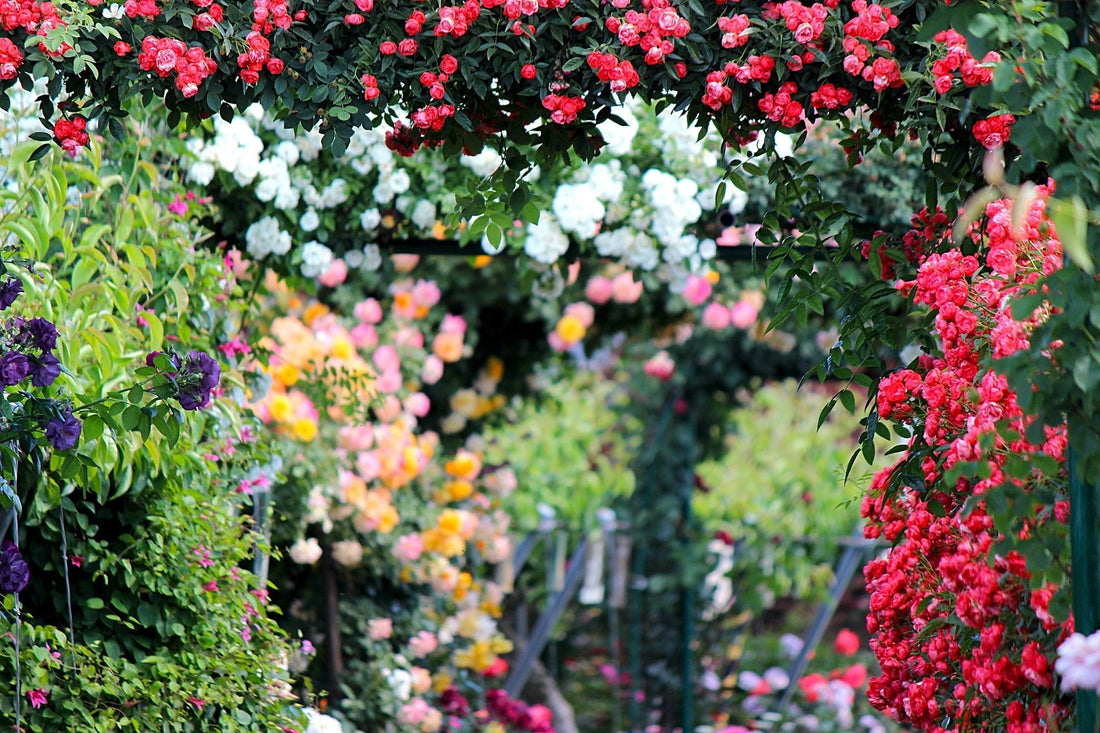The Timeless Allure of Rose Fragrance
The rose's intoxicating scent has done more than merely captivate—it has shaped human civilization's relationship with fragrance for millennia. From ancient Egyptian tombs, where dried rose petals were found among royal remains, to the bustling souks of Damascus, where rose essence once commanded prices higher than gold, this flower's aromatic influence spans continents and centuries. Modern perfumery continues to unravel the complex chemistry behind the rose's allure, identifying over 300 distinct volatile compounds that contribute to its legendary scent.
The Chemistry of Rose Fragrance
What makes a rose smell like a rose? The answer lies in a sophisticated molecular orchestra where beta-damascenone provides the rich, honey-like warmth, while geraniol and citronellol contribute the fresh, sweet undertones. Different rose varieties present unique combinations of these compounds, creating distinct olfactory signatures. The Damask rose (Rosa damascena) contains high levels of beta-damascenone and rose oxide, explaining its intense, classic rose fragrance, while the Tea rose offers lighter, citrusy notes due to its higher concentrations of citronellol.
Evolution and Cultivation Through History
The modern rose's journey began over 35 million years ago, as evidenced by fossil discoveries in Colorado. From its humble origins as a five-petaled wild flower, selective breeding has produced today's spectacular varieties with their elaborate petal formations and diverse fragrances. The Romans were perhaps the first to perfect rose cultivation at scale, developing greenhouses with mica windows to grow roses year-round. During the Han Dynasty in China, imperial gardens devoted entire fields to rose cultivation, leading to breakthrough hybridization techniques that still influence modern breeding.
The Art and Science of Rose Breeding
Modern rose breeding is a fascinating blend of traditional techniques and cutting-edge genetic science. Breeders like David Austin revolutionized the field by combining the charm of old garden roses with the disease resistance and repeat-flowering capabilities of modern varieties. The process of creating a new rose variety typically takes 7-9 years, involving careful selection from thousands of seedlings. Recent advances in CRISPR gene editing technology are opening new possibilities for developing roses with enhanced disease resistance and novel colors previously thought impossible.
Legendary Rose Gardens of the World
While Europe boasts many famous rose gardens, remarkable collections exist worldwide:
The Gardens of Shiraz
Persian gardens have cultivated roses since the fifth century BCE. The Eram Garden in Shiraz maintains this tradition, showcasing ancient varieties of Rosa damascena alongside modern Persian hybrids. The garden's design follows the traditional chahar bagh pattern, where flowing water and symmetrical pathways create a paradise-like setting. The garden's rose breeding program focuses on developing drought-resistant varieties while preserving traditional Persian rose scents.
The Moroccan Valley of Roses
In the foothills of Morocco's High Atlas Mountains, the Dades Valley transforms into a sea of pink roses every spring. Local Berber communities have cultivated Rosa damascena here for centuries, producing some of the world's finest rose water and oil. The annual Rose Festival in El-Kelaa M'Gouna celebrates the harvest with traditional music, dance, and the crowning of a Rose Queen.
The Japanese Heritage Rose Gardens
The Keisei Rose Gardens in Chiba Prefecture house one of the world's most diverse collections of heritage roses, including rare Japanese varieties like the Kiftsgate rose. The garden's innovative design combines traditional Japanese landscaping principles with modern rose cultivation techniques, creating unique viewing perspectives throughout the seasons.
The South African Rose Sanctuary
The Ludwig's Rose Farm near Pretoria represents the largest rose nursery in the Southern Hemisphere. This unique climate allows for year-round rose cultivation and has led to the development of heat-tolerant varieties that are revolutionizing rose growing in warm climates. The farm's breeding program has produced several award-winning varieties specifically adapted to African conditions.
The Chandni Chowk Rose Market
In Old Delhi, the historic Chandni Chowk market has traded roses for over three centuries. Every morning, tons of fresh roses arrive from surrounding farms, supplying both the cut flower trade and traditional attar (natural perfume) makers who still use ancient distillation techniques. The market's rose water producers maintain centuries-old distillation methods, creating products prized throughout South Asia.
The Australian Heritage Rose Garden
Located in Albury, New South Wales, this garden specializes in preserving roses that arrived with European settlers, including varieties now extinct in their native countries. The collection provides valuable genetic material for breeding programs focused on developing roses suited to arid conditions.
Roses in Modern Science
Recent scientific research has revealed extraordinary properties of roses that extend far beyond their traditional uses:
Bioengineering Applications
Swedish researchers at Linköping University have pioneered the development of "electronic roses" by introducing conductive polymers into living rose tissues. The plant's vascular system naturally distributes these polymers, creating organic circuits that could revolutionize plant monitoring and modification. These cyber-plants can sense drought conditions, detect pathogens, and even regulate their own growth hormones in response to environmental changes.
Medical Research
The therapeutic potential of roses continues to surprise researchers:
- Neurological Studies: Research at Japanese universities has demonstrated that rose compounds influence neurotransmitter activity, particularly affecting serotonin and dopamine pathways. This could lead to new treatments for anxiety, depression, and sleep disorders.
- Wound Healing: Rose-derived compounds show promising antibacterial and tissue-regenerating properties. Studies indicate that certain rose extracts can accelerate wound healing and reduce scarring.
- Cancer Research: Scientists have isolated compounds from specific rose varieties that show potential anti-cancer properties, particularly in breast and colon cancer cell lines.
Environmental Technology
Roses are proving valuable in environmental science:
- Phytoremediation: Certain rose varieties excel at absorbing heavy metals from contaminated soil, offering natural solutions for environmental cleanup.
- Air Quality Monitoring: Research teams are developing rose-based biosensors that change petal color in response to air pollutants, creating living air quality monitors.
- Climate Change Research: Rose timing records spanning centuries are providing valuable data about climate change patterns and their effects on plant life cycles.
The Future of Roses
As climate change threatens traditional rose-growing regions, breeders are developing more resilient varieties that can thrive in extreme conditions. Urban rose gardens are being reimagined as vital components of city biodiversity, supporting pollinators and contributing to urban cooling. Meanwhile, molecular biologists are exploring the possibility of recreating extinct rose varieties using preserved genetic material, potentially reviving lost fragrances from history.
Culinary Renaissance
Beyond traditional applications in Middle Eastern and Indian cuisine, innovative chefs are discovering new culinary uses for roses:
Molecular Gastronomy and Modern Cuisine
The culinary world has embraced roses in increasingly sophisticated ways:
Advanced Techniques
- Ultrasonic Rose Extraction: Chefs use ultrasonic technology to extract pure rose essences without heat, preserving delicate flavor compounds.
- Cryodistillation: Flash-freezing rose petals before extraction creates intensely concentrated flavors for microscale garnishes.
- Rose Spherification: Using molecular gastronomy techniques to create liquid-filled spheres that burst with rose flavor.
Innovation in Fine Dining
- Three-Michelin-starred restaurant Alinea in Chicago serves a floating rose petal dessert using electromagnetic levitation.
- Copenhagen's Noma has experimented with fermented rose petals to create complex umami flavors.
- Japanese kaiseki restaurants incorporate preserved rose techniques to extend the seasonal availability of rose flavors.
Contemporary Beverage Applications
- Craft Cocktails: Rose Smoke Infusion, Rose Crystal Garnishes, Variety-Specific Bitters.
- Craft Beer: Rose Sour Ales, Rose Hop Hybrids, Imperial Rose Stouts.
- Non-Alcoholic Developments: Botanical Waters, Kombucha Innovations, Luxury Rose Coffee.
Commercial Applications
Food scientists have developed new ways to stabilize rose flavors:
- Microencapsulation techniques that preserve rose compounds for commercial food production.
- Natural rose flavor enhancers that maintain intensity through cooking and freezing.
- Rose-based natural food colorants that provide both color and subtle fragrance.
- Shelf-stable rose extracts for mass-market beverages and confections.
Roses in Social Media and Digital Culture
TikTok Rose Trends
The rose has found new life on social media, particularly among Gen Z creators:
- #RoseHacks videos showcase innovative uses of rose products, from DIY skincare to creative photography.
- Rose garden tours and cultivation tips regularly go viral.
- "Aesthetic rose content" featuring roses in fashion, art, and lifestyle contexts.
- Rose-themed ASMR content, particularly popular in skincare routines.
Instagram-Worthy Rose Experiences
- Rose gardens becoming popular photoshoot locations.
- Rose cafes featuring rose-decorated lattes and desserts.
- Rose walls and installations at events and retail spaces.
- Rose-themed pop-up experiences and interactive exhibitions.
Digital Rose Communities
- Online rose cultivation communities sharing growing tips.
- Virtual rose garden planning tools and apps.
- Rose photography communities on Instagram.
- Rose appreciation groups on Discord and Reddit.
Self-Care and Wellness
Rose in Modern Skincare
Natural rose products have seen a resurgence in popularity, particularly among those seeking clean, sustainable beauty solutions. The SOAPYARD Rose Petal Exfoliant Soap exemplifies this trend, combining traditional rose benefits with modern skincare science. This handcrafted soap harnesses the gentle exfoliating properties of rose petals while maintaining the skin's natural moisture balance.
Mindfulness and Roses
- Rose gardening as meditation.
- Rose-scented aromatherapy for stress relief.
- Rose tea ceremonies and mindful consumption.
- Digital rose gardens for virtual relaxation.
Essential Rose Resources
- American Rose Society
- World Federation of Rose Societies
- Royal Horticultural Society Roses
- Rose Magazine Digital
Social Media Rose Communities
- Instagram: #RosesOfInstagram, #RoseGarden, #RoseCare
- TikTok: #RoseGrower, #RoseHacks, #RoseSkincare
- Pinterest: Rose Garden Ideas, Rose Care Tips
- YouTube: Rose Cultivation Channels
Shopping and Products
Educational Resources
Scientific Research
- Electronic rose research at Linköping University
- Royal Society of Chemistry's rose research collection
Official Rose Organizations
Major Rose Gardens
- Eram Garden, Iran: UNESCO World Heritage site listing
- The Europa-Rosarium in Sangerhausen, Germany
- Royal Botanical Gardens
Modern Applications
- For molecular gastronomy: Alinea restaurant's documented work with roses
Conclusion:
As we embrace a renewed fascination with roses, their presence in both traditional and contemporary spaces continues to evolve. The fashion revival of roses is not just about the flowers themselves, but the experiences they offer—through fragrance, art, cuisine, and self-care. This enduring symbol of beauty is more than just a fleeting trend; it reflects an appreciation for nature’s elegance and its ability to adapt to modern sensibilities. Whether in our gardens, on our social media feeds, or in our skincare routines, roses are here to stay, enchanting us with their timeless allure and ever-expanding possibilities.
The rose continues to evolve from its ancient origins, finding new relevance in science, technology, and culture. As we face environmental challenges and seek sustainable solutions, the adaptability and resilience of roses offer lessons and opportunities for the future. Whether in traditional gardens or cutting-edge laboratories, roses remain at the forefront of human innovation and artistic expression.

